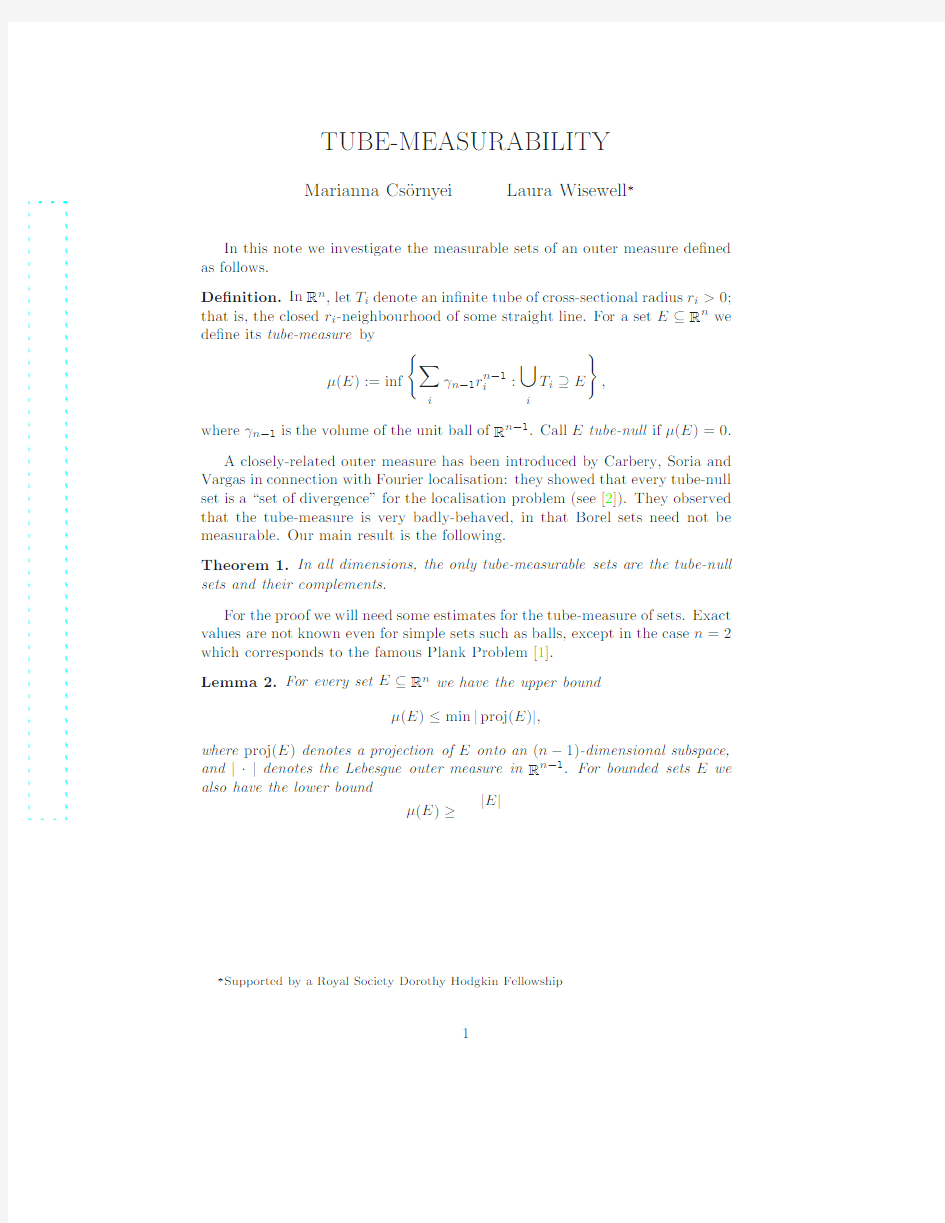Tube-measurability


a r
X i
v
:m
a
t h /
7
3
8
7
v
1
[
m
a
t h
.
C
A
]
2
7
M a
r
2
7
TUBE-MEASURABILITY Marianna Cs¨o rnyei Laura Wisewell ?In this note we investigate the measurable sets of an outer measure de?ned as follows.De?nition.In R n ,let T i denote an in?nite tube of cross-sectional radius r i >0;that is,the closed r i -neighbourhood of some straight line.For a set E ?R n we de?ne its tube-measure by μ(E ):=inf i γn ?1r n ?1i : i T i ?E ,where γn ?1is the volume of the unit ball of R n ?1.Call E tube-null if μ(E )=0.A closely-related outer measure has been introduced by Carbery,Soria and Vargas in connection with Fourier localisation:they showed that every tube-null set is a “set of divergence”for the localisation problem (see [2]).They observed that the tube-measure is very badly-behaved,in that Borel sets need not be measurable.Our main result is the following.Theorem 1.In all dimensions,the only tube-measurable sets are the tube-null sets and their complements.For the proof we will need some estimates for the tube-measure of sets.Exact values are not known even for simple sets such as balls,except in the case n =2which corresponds to the famous Plank Problem [1].Lemma 2.For every set E ?R n we have the upper bound μ(E )≤min |proj(E )|,where proj(E )denotes a projection of E onto an (n ?1)-dimensional subspace,and |·|denotes the Lebesgue outer measure in R n ?1.For bounded sets E we also have the lower bound μ(E )≥|E |
?Supported by a Royal Society Dorothy Hodgkin Fellowship
1
Proof of Lemma2.The upper bound is obvious,by covering E with parallel tubes.For the lower bound,note that for any tube T of cross-sectional radius r we have|E∩T|≤diam(E)γn?1r n?1.So if ∞i=0T i?E,we have
|E|= E∩∞ i=0T i ≤∞ i=0|E∩T i|≤diam(E)∞ i=0γn?1r n?1i,
from which the inequality follows by taking the in?mum.
Next we show that the upper bound is the exact value in the case of sets that are Cartesian products with R.
Lemma3.If A?R n?1,thenμ(A×R)=|A|.
Proof.The upper bound is immediate from the previous lemma.For the lower bound,observe that for all R>0we have
2R|A|
μ(A×R)≥μ(A×[?R,R])≥
as before into the union of square tubes of some common smaller widthδ>0, and from each of the two collections select a tube still satisfying(2).
So we now have someδ>0(which depends onε)and two copies of [?δ,δ]n?1×R that we denote by R1and R2,such that
(1?ε)μ(R1)≤μ(R1∩E)
(3)
(1?ε)μ(R2)≤μ(R2\E).
Choose disjointδ-balls B1?R1,B2?R2.We now want to pass from balls to very eccentric sets,because for such sets the upper and lower bounds of Lemma2are almost equal.So into each ball B i(i=1,2)place a cuboid C i of diameter2δwith n?1of its edges all equal to some smallη>0to be chosen later.By Pythagoras’Theorem,their measure is
|C1|=|C2|=ηn?1
?ε(2δ)n?1 ,
2δ
that is,
1≥2 |C1|
1?(n?1)(η/2δ)2.
So we choose ourεandδas follows:?rst let
p< 4(n?1)
so that
1?(n?1)p2?ε/p n?1>1/2.
3
Then in the above construction use thisεand letη=2δp.Then(4)gives 1≥2
